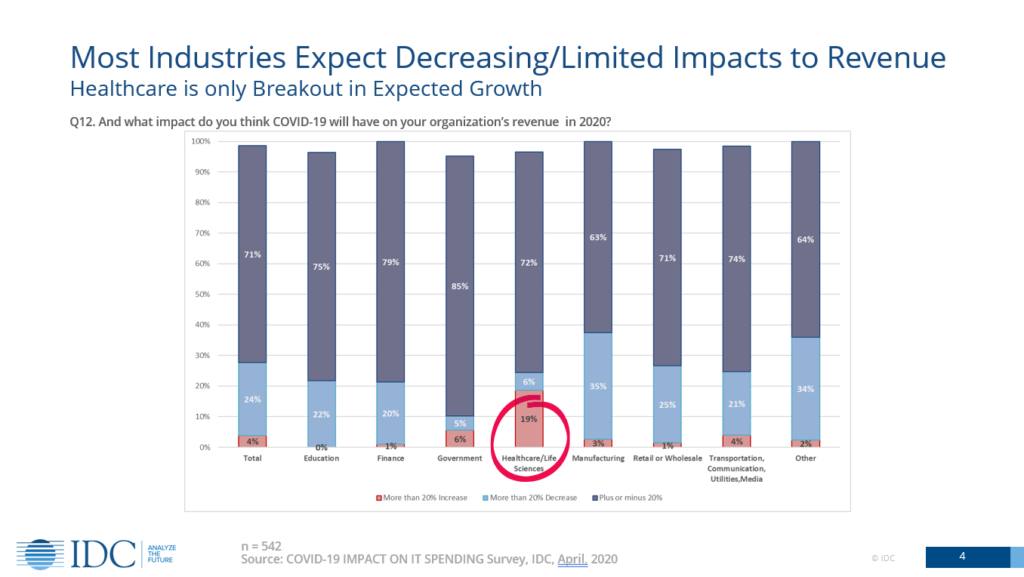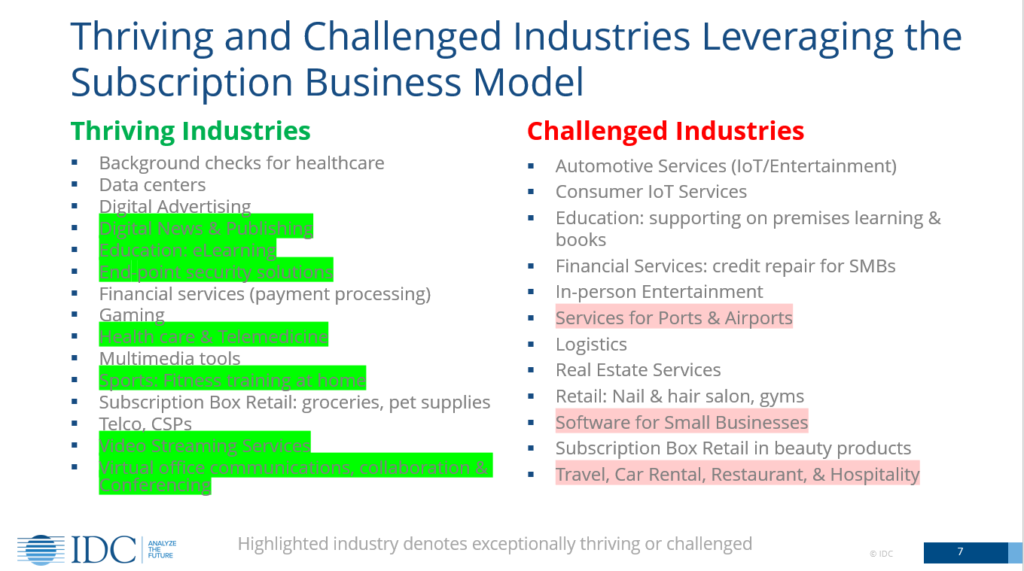It’s no surprise now that COVID-19’s impact on the world’s economies has been massive. Given my focus on business models, I wanted to understand the impact to businesses using the recurring business model, which includes subscription, consumption, and outcome. This blog entry is a subset of research found in the full report here: How Has COVID-19 Impacted Businesses Using Recurring Business Models?
Since these recurring models use a time-bound contract to enforce an ongoing service relationship for a fee, there’s a guarantee that vendors will get paid for services rendered. However, these are unprecedented times and many businesses are by law forced to temporarily close or change the way they do business while the world attempts to flatten the pandemic’s growth curve to ensure our healthcare systems can handle the amount of Covid-19 patients.
Since early April, IDC has been surveying leaders (C-suite, VPs & directors across IT and LoB) every two weeks to understand the impact to technology markets. One of the questions we asked was the expected revenue impacts in 2020. Pivoting this answer by industry, 71% of respondents expected their revenues would be in the +/- 20% range, with 24% estimating their revenues would decline more than 20% and only 4% estimating revenues would increase more than 20%. See the figure below for the industry view, but Healthcare respondents were the breakout in expected growth of 19%.

A Recurring Perspective
To get a perspective of how COVID-19 has affected companies using subscription/recurring business models, I interviewed 12 vendors of subscription management applications along with a few customers, including Aria Systems, Bearingpoint//Beyond, 2Checkout, BillingPlatform, Gotransverse, Oracle, Oracle NetSuite, RecVue, Recurly, Salesforce, Vindicia, and Zuora. The combined revenue across all customers monetized by these vendors is over $150 billion annually. While the majority of the customer base is in technology companies, there is a significant chunk in the retail, education, and business/consumer services.
The first question I asked vendors is “how is your subscription management business doing?” and what I learned is that many vendors are optimistic about business in 2020, with some raising their growth estimates and still hiring. They have been seeing lots of urgency for selling online and moving quicker to a recurring model for post-Covid-19. The main downside is that projects have been pushed out in time and reduced project scope, but it largely depends if the industry is in the challenged list.
Which leads me to the next question: within your customer base, which industries are thriving or being challenged? See Figure 2 for the full list. For the most part, it follows common sense that industries relied on face to face experiences and travel were challenged the most and those that enabled digital or remote experiences thrived. Some subscription management vendors gave me data to show how much their base of customers have been impacted which was very enlightening, but I could not normalize the data across the datasets to include here.
However, Zuora has a nice publicly available “Subscription Impact Report” that they have been updating monthly and it offers industry detailed performance data, along with an overall summary of their customer base. In their report, they now show 53.3% of their base seeing limited impact in their revenues (-/+ 25%) and 22.5% growing more than 25%, which is a very different story than the expected revenue impacts from IDC’s survey. While the two sets cannot be directly compared since they represent different markets and business models, it is a meaningful data point and broadly agrees with data from other subscription management vendors.

When asked how subscription management vendors are helping recurring businesses react to COVID-19’s impacts, they are helping them triage end customers and offering relief, such as:
- If “seats” are idle because users cannot go to work or use the service, they are offering subscription pauses (in some cases proactively) and extending their contract terms
- If customers are unable to pay, they are offering discounts, credits, or adjusting payment terms
- Creating ramped deals to increase the price of a subscription over time as ability to pay increases
The bottom line is that they are trying hard to keep the customers they have as they know the cost to acquire new customers is much higher than the concessions they are offering their impacted customers.
So What?
While it is still early in the lifecycle of the pandemic, it appears that companies with recurring business models have weathered the Covid-19 storm better than other models. This makes sense because:
- Recurring business models are contract based with an ongoing service
- Due to the contract and recurring revenue, companies are aligned to their customer’s success
- Leading recurring revenue companies have formal customer success teams which leverage usage data to provide real time insights to automate customer engagement and training
If your company does offer a recurring business model, consider these words of wisdom that I harvested from subscription management vendors and customers:
- Reach out and listen to your customers
- Divide your customer list and engage execs and customer success staff to call customers with a script to ask questions and capture situation
- Let them know your company is focused on their success
- Have empathy and react
- Offer or proactively pause or extend their subscription if users cannot access your service
- Offer credits, discounts, or payment term changes if customers cannot pay
- Sense engagement
- Track and analyze product usage to understand customer value…compare to benchmarks
- Engage with customers having issues or needing training
- Grow new customers
- Consider offering new products, offers or bundles, leveraging freemium, timed trials or the credits that might have been issued
- Focus on delivery excellence to sense and react to customer usage using training or incentives
If your business does not offer a recurring business model, this should be a good motivator to consider adopting one. There are several good examples of product and hardware companies starting recurring business models and there are several great choices for SaaS-based subscription management applications which can be onboarded quickly. Let me know if I can help you through this journey.
Technology has proven to be critical to enabling businesses’ responses to the COVID-19 pandemic. Explore how organizations will leverage technology long-term as they move from crisis to recovery and journey to the next normal with IDC’s extensive COVID-19 research and advice.




